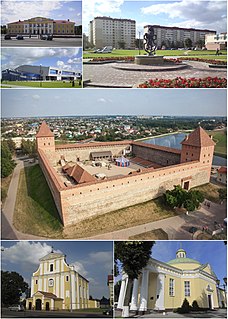
Lida is a city in western Belarus in Hrodna Voblast, situated 160 kilometres west of Minsk.

Wojtek was a Syrian brown bear bought, as a young cub, at a railway station in Hamadan, Iran, by Polish II Corps soldiers who had been evacuated from the Soviet Union. In order to provide for his rations and transportation, he was eventually enlisted officially as a soldier with the rank of private, and was subsequently promoted to corporal.

Operation Mińsk was a military offensive of the Polish Army resulting in the recapture of Minsk from the Bolsheviks around August 8, 1919. The victory allowed the Polish troops to advance further into the Russian-controlled Lithuania and Belarus, and thus present the Bolsheviks with a fait accompli by driving them out of the newly acquired territories. The main Polish attack was in the direction of Maladzechna, Minsk, and Polatsk along the railroad lines. On August 6 the Polish Army took over Slutsk, and Minsk two days later. The Polish control over the railway lines, prevented the Russians from bringing in reinforcements. By the end of August, the forces of Józef Piłsudski took over Barysau and Babruisk, and forced Lenin to return to the negotiating table. Operation Mińsk was considered critical for the confirmation of Polish presence in the Kresy macroregion at the time of the reconstitution of sovereign Poland. The negotiations however, failed, which led to the Soviet invasion of ethnic Poland in July 1920.
The Sonata in D minor was composed, circa 1709–15, by George Frideric Handel for recorder and keyboard (harpsichord). The work is also referred to as Opus 1 No. 9a. Another catalogue of Handel's music refers to the work as HHA iv/18,19,45.
It is impossible to say how many flute sonatas were composed by George Frideric Handel, but the correct number is somewhere between none and eight. There are many reasons for the confusion: some of the sonatas were originally written for other instruments, some have uncertain authenticity, some contain borrowings from other Handel works, and some were published without Handel's knowledge. At least six of the sonatas are known to contain music written by Handel, although he may not have intended some of them to have been played by the flute.
The Sonata in A minor was composed by George Frideric Handel for recorder and harpsichord. The work is also referred to as Opus 1 No. 4, and was first published in 1732 by Walsh. Other catalogues of Handel's music have referred to the work as HG xxvii,15; and HHA iv/3,21.
The Sonata in F major was composed by George Frideric Handel for recorder and harpsichord. The work is also referred to as Opus 1 No. 11, and was first published in 1732 by Walsh. Other catalogues of Handel's music have referred to the work as HG xxvii,40; and HHA iv/3,52.
The Orchestra Conductor is a 1980 Polish drama film directed by Andrzej Wajda. It was entered into the 30th Berlin International Film Festival, where Andrzej Seweryn won the Silver Bear for Best Actor. It was also shown at the 1980 New York Film Festival.
The sopranino recorder is the second smallest recorder of the modern recorder family, and was the smallest before the 17th century.
The First Army was a field army of the Polish Army that existed during the Polish–Soviet War.
The Battle of Lida took place on 16 and 17 April 1919 around the city of Lida during the Polish–Soviet War of 1919–20. During World War I Lida was occupied by the German troops. In 1919 the Red Army briefly established Soviet power here.

Christian Democracy was a political alliance in Poland.

The Party of Polish Democracy was a political party in Poland.
The garklein recorder in C, also known as the sopranissimo, is the smallest size of the recorder family. Its range is C6–A7 (C8). The name garklein is German for "quite small", and is also sometimes used to describe the sopranino in G (Reuter 2002, 81). Although some modern German makers use the single-word form Garkleinflötlein, this is without historical precedent (Bär 2002, 152n1). Double holes for the two lowest notes (used on the larger recorders to achieve a fully chromatic scale) are uncommon. The instrument is usually notated in the treble clef two octaves lower than its actual sound. The garklein recorder is only about 16 to 18 cm long and is different from larger recorders in that it is usually made in one piece due to its size.
The sub-great bass recorder, also known as contra great bass and contrabass, is a recorder with the range C–d1 (g1). It is manufactured in both bent ("knick") and square designs. The design with a square or rectangular cross-sections was first patented in 1975 by Joachim and Herbert Paetzold. They are made from plywood and have a doubled-back bore like a bassoon, which reduces the exterior length of the instrument. They also have wooden keys. Through this special and proprietary design, the instrument can be played with a very short bocal.
The sub-contrabass recorder is a member of the recorder with a low note of FF. It is manufactured in a design with a square or rectangular cross-section, which was first patented in 1975 by Joachim and Herbert Paetzold. They are made from plywood and have a doubled-back bore like a bassoon, which reduces the exterior length of the instrument. They also have wooden keys. Through this special and proprietary design, the instrument can be played with a very short bocal.
The tenor recorder is a member of the recorder family. It has the same form as a soprano recorder and an alto recorder, but it produces a lower sound than either; a still lower sound is produced by the bass recorder.
This page is based on this
Wikipedia article Text is available under the
CC BY-SA 4.0 license; additional terms may apply.
Images, videos and audio are available under their respective licenses.



